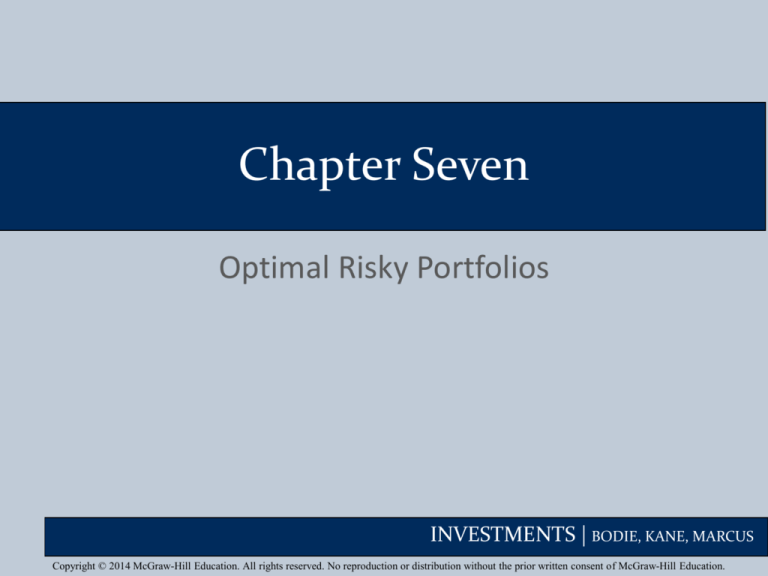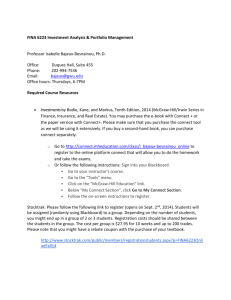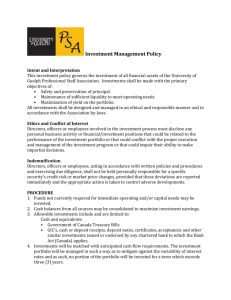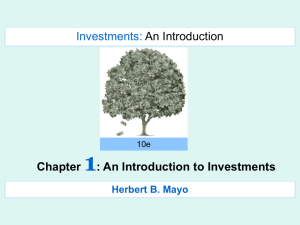
Chapter Seven
Optimal Risky Portfolios
INVESTMENTS | BODIE, KANE, MARCUS
Copyright © 2014 McGraw-Hill Education. All rights reserved. No reproduction or distribution without the prior written consent of McGraw-Hill Education.
Chapter Overview
• The investment decision:
• Capital allocation (risky vs. risk-free)
• Asset allocation (construction of the risky
portfolio)
• Security selection
• Optimal risky portfolio
• The Markowitz portfolio optimization model
• Long- vs. short-term investing
7-2
INVESTMENTS | BODIE, KANE, MARCUS
The Investment Decision
•
Top-down process with 3 steps:
1. Capital allocation between the risky portfolio and
risk-free asset
2. Asset allocation across broad asset classes
3. Security selection of individual assets within each
asset class
7-3
INVESTMENTS | BODIE, KANE, MARCUS
Diversification and Portfolio Risk
• Market risk
• Risk attributable to marketwide risk sources and
remains even after extensive diversification
• Also call systematic or nondiversifiable
• Firm-specific risk
• Risk that can be eliminated by diversification
• Also called diversifiable or nonsystematic
7-4
INVESTMENTS | BODIE, KANE, MARCUS
Figure 7.1 Portfolio Risk and
the Number of Stocks in the Portfolio
Panel A: All risk is firm specific. Panel B: Some risk is systematic or marketwide.
7-5
INVESTMENTS | BODIE, KANE, MARCUS
Figure 7.2 Portfolio Diversification
7-6
INVESTMENTS | BODIE, KANE, MARCUS
Portfolios of Two Risky Assets
• Portfolio risk (variance) depends on the
correlation between the returns of the
assets in the portfolio
• Covariance and the correlation coefficient
provide a measure of the way returns of
two assets move together (covary)
7-7
INVESTMENTS | BODIE, KANE, MARCUS
Portfolios of Two Risky Assets:
Return
• Portfolio return: rp = wDrD + wErE
•
•
•
•
wD = Bond weight
rD = Bond return
wE = Equity weight
rE = Equity return
E(rp) = wD E(rD) + wEE(rE)
7-8
INVESTMENTS | BODIE, KANE, MARCUS
Portfolios of Two Risky Assets:
Risk
• Portfolio variance:
p2 wD2 D2 wE2 E2 2wD wE Cov rD , rE
•
D2 = Bond variance
•
2
E
= Equity variance
• Cov rD , rE = Covariance of returns for bond
and equity
7-9
INVESTMENTS | BODIE, KANE, MARCUS
Portfolios of Two Risky Assets:
Covariance
• Covariance of returns on bond and equity:
Cov(rD,rE) = DEDE
• D,E = Correlation coefficient of returns
• D = Standard deviation of bond returns
• E = Standard deviation of equity returns
7-10
INVESTMENTS | BODIE, KANE, MARCUS
Portfolios of Two Risky Assets:
Correlation Coefficients
• Range of values for 1,2
- 1.0 > > +1.0
• If = 1.0, the securities are perfectly positively
correlated
• If = - 1.0, the securities are perfectly negatively
correlated
7-11
INVESTMENTS | BODIE, KANE, MARCUS
Portfolios of Two Risky Assets:
Correlation Coefficients
• When ρDE = 1, there is no diversification
P wE E wD D
• When ρDE = -1, a perfect hedge is possible
wE
7-12
D
D E
1 wD
INVESTMENTS | BODIE, KANE, MARCUS
Table 7.2 Computation of Portfolio Variance
From the Covariance Matrix
7-13
INVESTMENTS | BODIE, KANE, MARCUS
Figure 7.3 Portfolio Expected Return
7-14
INVESTMENTS | BODIE, KANE, MARCUS
Figure 7.4 Portfolio Standard Deviation
7-15
INVESTMENTS | BODIE, KANE, MARCUS
Figure 7.5 Portfolio Expected Return as a
Function of Standard Deviation
7-16
INVESTMENTS | BODIE, KANE, MARCUS
The Minimum Variance Portfolio
• The minimum variance portfolio is the portfolio
composed of the risky assets that has the smallest
standard deviation; the portfolio with least risk
• The amount of possible risk reduction through
diversification depends on the correlation:
• If = +1.0, no risk reduction is possible
• If = 0, σP may be less than the standard deviation of
either component asset
• If = -1.0, a riskless hedge is possible
7-17
INVESTMENTS | BODIE, KANE, MARCUS
Figure 7.6 The Opportunity Set of the Debt
and Equity Funds and Two Feasible CALs
7-18
INVESTMENTS | BODIE, KANE, MARCUS
The Sharpe Ratio
• Maximize the slope of the CAL for any possible
portfolio, P
• The objective function is the slope:
Sp
E rp rf
p
• The slope is also the Sharpe ratio
7-19
INVESTMENTS | BODIE, KANE, MARCUS
Figure 7.7 Debt and Equity Funds with the
Optimal Risky Portfolio
7-20
INVESTMENTS | BODIE, KANE, MARCUS
Figure 7.8 Determination of the Optimal
Overall Portfolio
7-21
INVESTMENTS | BODIE, KANE, MARCUS
Figure 7.9 The Proportions of the Optimal
Complete Portfolio
7-22
INVESTMENTS | BODIE, KANE, MARCUS
Markowitz Portfolio Optimization
Model
• Security selection
• The first step is to determine the risk-return
opportunities available
• All portfolios that lie on the minimum-variance
frontier from the global minimum-variance
portfolio and upward provide the best risk-return
combinations
7-23
INVESTMENTS | BODIE, KANE, MARCUS
Figure 7.10 The Minimum-Variance
Frontier of Risky Assets
7-24
INVESTMENTS | BODIE, KANE, MARCUS
Markowitz Portfolio Optimization
Model
• Search for the CAL with the highest reward-tovariability ratio
• Everyone invests in P, regardless of their
degree of risk aversion
• More risk averse investors put more in the riskfree asset
• Less risk averse investors put more in P
7-25
INVESTMENTS | BODIE, KANE, MARCUS
Figure 7.11 The Efficient Frontier of
Risky Assets with the Optimal CAL
7-26
INVESTMENTS | BODIE, KANE, MARCUS
Markowitz Portfolio Optimization
Model
• Capital Allocation and the Separation Property
• Portfolio choice problem may be separated into
two independent tasks
• Determination of the optimal risky portfolio is
purely technical
• Allocation of the complete portfolio to risk-free
versus the risky portfolio depends on personal
preference
7-27
INVESTMENTS | BODIE, KANE, MARCUS
Figure 7.13 Capital Allocation Lines with
Various Portfolios from the Efficient Set
7-28
INVESTMENTS | BODIE, KANE, MARCUS
Markowitz Portfolio Optimization
Model
• The Power of Diversification
• Remember:
wi w j Cov ri , rj
n
2
p
n
i 1 j 1
• If we define the average variance and average
covariance of the securities as:
1 n 2
i
n i 1
2
n
n
1
Cov
Cov ri , rj
n n 1 j 1 i 1
j i
7-29
INVESTMENTS | BODIE, KANE, MARCUS
Markowitz Portfolio Optimization
Model
• The Power of Diversification
• We can then express portfolio variance as
1 2 n 1
Cov
n
n
2
p
• Portfolio variance can be driven to zero if the
average covariance is zero (only firm specific risk)
• The irreducible risk of a diversified portfolio
depends on the covariance of the returns, which is
a function of the systematic factors in the
economy
7-30
INVESTMENTS | BODIE, KANE, MARCUS
Table 7.4 Risk Reduction of
Equally Weighted Portfolios
7-31
INVESTMENTS | BODIE, KANE, MARCUS
Markowitz Portfolio Optimization
Model
• Optimal Portfolios and Nonnormal Returns
• Fat-tailed distributions can result in extreme
values of VaR and ES and encourage smaller
allocations to the risky portfolio
• If other portfolios provide sufficiently better VaR
and ES values than the mean-variance efficient
portfolio, we may prefer these when faced with
fat-tailed distributions
7-32
INVESTMENTS | BODIE, KANE, MARCUS
Risk Pooling and
the Insurance Principle
• Risk pooling
• Merging uncorrelated, risky projects as a means to
reduce risk
• It increases the scale of the risky investment by
adding additional uncorrelated assets
• The insurance principle
• Risk increases less than proportionally to the
number of policies when the policies are
uncorrelated
• Sharpe ratio increases
7-33
INVESTMENTS | BODIE, KANE, MARCUS
Risk Sharing
• As risky assets are added to the portfolio, a
portion of the pool is sold to maintain a risky
portfolio of fixed size
• Risk sharing combined with risk pooling is the
key to the insurance industry
• True diversification means spreading a
portfolio of fixed size across many assets, not
merely adding more risky bets to an evergrowing risky portfolio
7-34
INVESTMENTS | BODIE, KANE, MARCUS
Investment for the Long Run
Long-Term Strategy
Short-Term Strategy
• Invest in the risky
portfolio for 2 years
• Invest in the risky
portfolio for 1 year and
in the risk-free asset for
the second year
• Long-term strategy is
riskier
• Risk can be reduced by
selling some of the
risky assets in year 2
• “Time diversification”
is not true
diversification
7-35
INVESTMENTS | BODIE, KANE, MARCUS








